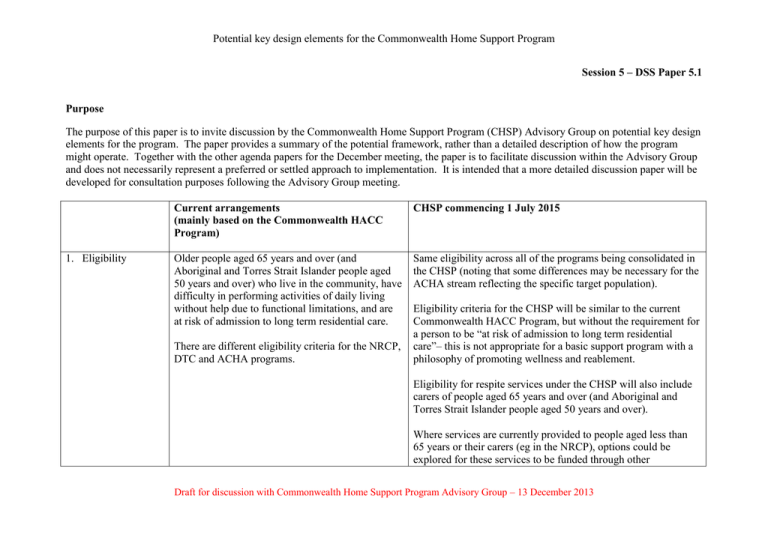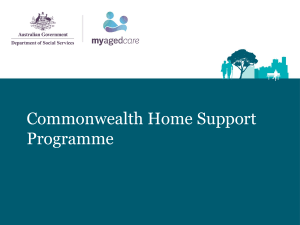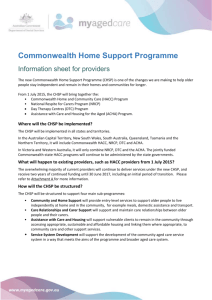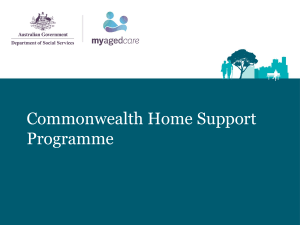Summary of key design elements
advertisement

Potential key design elements for the Commonwealth Home Support Program Session 5 – DSS Paper 5.1 Purpose The purpose of this paper is to invite discussion by the Commonwealth Home Support Program (CHSP) Advisory Group on potential key design elements for the program. The paper provides a summary of the potential framework, rather than a detailed description of how the program might operate. Together with the other agenda papers for the December meeting, the paper is to facilitate discussion within the Advisory Group and does not necessarily represent a preferred or settled approach to implementation. It is intended that a more detailed discussion paper will be developed for consultation purposes following the Advisory Group meeting. 1. Eligibility Current arrangements (mainly based on the Commonwealth HACC Program) CHSP commencing 1 July 2015 Older people aged 65 years and over (and Aboriginal and Torres Strait Islander people aged 50 years and over) who live in the community, have difficulty in performing activities of daily living without help due to functional limitations, and are at risk of admission to long term residential care. Same eligibility across all of the programs being consolidated in the CHSP (noting that some differences may be necessary for the ACHA stream reflecting the specific target population). There are different eligibility criteria for the NRCP, DTC and ACHA programs. Eligibility criteria for the CHSP will be similar to the current Commonwealth HACC Program, but without the requirement for a person to be “at risk of admission to long term residential care”– this is not appropriate for a basic support program with a philosophy of promoting wellness and reablement. Eligibility for respite services under the CHSP will also include carers of people aged 65 years and over (and Aboriginal and Torres Strait Islander people aged 50 years and over). Where services are currently provided to people aged less than 65 years or their carers (eg in the NRCP), options could be explored for these services to be funded through other Draft for discussion with Commonwealth Home Support Program Advisory Group – 13 December 2013 Potential key design elements for the Commonwealth Home Support Program Commonwealth or state government programs from 1 July 2015, rather than through the CHSP. 2. Entering the program Potential clients are able to contact service providers directly (perhaps after contacting My Aged Care or an ACAT, although this is not a requirement). For further detail, see the client pathway and the separate paper on Client Entry and Assessment in the CHSP. In summary: No consistent approach to assessment nationally. Assessment may be conducted by Access Points in some states and regions or by individual HACC service providers using a variety of tools. From July 2015, all new clients will need to enter the CHSP through the Aged Care Gateway (this may involve being referred to the Gateway if the client contacts a service provider directly or the service provider facilitating online client self-registration).1 No central client record. The Gateway will conduct a phone-based screening. A central client record will be established as part of this process. Following the initial screening, some clients will be referred to a face-to-face assessment (where available) using a standardised assessment tool. Protocols will be developed as to which clients should be referred for a face-to-face assessment. Regionally-based face-to-face assessment services will be progressively implemented across Australia, building on existing services, eg in Victoria and WA. 3. Wellness and reablement focus Service providers are encouraged to adopt a wellness or reablement approach in service delivery to clients, and there has historically been some The CHSP will have a focus on wellness and reablement throughout the program. See separate paper on Client Entry 1 Different arrangements may apply for ACHA clients. The manner in which carers will interact with the Gateway and services is still subject to finalising the business model for Carer Support Centres, particularly how the Centres will interact with the Gateway and the CHSP. Draft for discussion with Commonwealth Home Support Program Advisory Group – 13 December 2013 Potential key design elements for the Commonwealth Home Support Program work to develop this at a jurisdictional level by some state governments, but there is currently no systematic approach to restorative care or reablement services across the Commonwealth HACC Program. There is also currently no incentive for providers to deliver fewer services to a larger number of clients or to take on new clients and Assessment in the CHSP. This will be implemented through: the introduction of regionally-based face-to-face assessment services; a standardised national assessment tool which includes a focus on wellness and reablement; goal oriented support plans for clients; a greater focus on wellness and reablement in staff training and service delivery supported by funding for sector support and development, eg development of best practice guidelines; the introduction of quality indicators relating to client wellness and reablement. In addition, the CHSP could include a separate funding stream (or service type), which would provide short-term incentive restorative care services to suitable clients, If adopted, this would provide intensive services over a 8-12 week period to improve the functional status and independence of clients and minimise the need for ongoing services. The services would be a planned program of interventions delivered or co-ordinated by a multidisciplinary health professional team, potentially building on current DTC and HACC funded allied health services. The restorative care stream could commence in July 2015 in a small number of regions, with the potential for expansion in the future. 4. Services and expenditure per client No limit on the amount or type of services that a client can receive. A client can potentially receive the same or different kinds of services from multiple service providers, exceeding the support available under a Home Care Package. The CHSP will be positioned as a basic support program for older people and their carers to assist people to remain living independently in the community. The NACA discussion paper on CHSP design suggests that Draft for discussion with Commonwealth Home Support Program Advisory Group – 13 December 2013 Potential key design elements for the Commonwealth Home Support Program expenditure per CHSP client should generally be less than the level of funding available under a Home Care Level 2 package (currently around $13,600 pa). However, expenditure up to this level would potentially position the CHSP above a basic support program and not be sustainable into the future. Average expenditure per client under the Commonwealth HACC Program is currently around $2,300 per annum. Clients who require long-term case management or receive several ongoing different service types or a high number of hours of care per week will generally be beyond the scope of the CHSP. Other more appropriate care options (including home care or residential care where appropriate) should be encouraged for these clients. Where a client has been assessed as eligible for a Home Care Packages but is unable to access a package, the client will be able to receive services under the CHSP, as an interim arrangement, but only to a basic level of support consistent with other clients under the CHSP. There will not be a mechanism to enforce a strict monetary cap or maximum level of services per CHSP client from July 2015, but the introduction of a more rigorous and standardised approach to assessment will provide greater scope to ensure that services under the CHSP are appropriate for a client’s needs. In the longer term, the introduction of a centralised client record will provide the capacity for closer monitoring of the services being used by individual clients. 5. Type of services A range of services are funded in 7 service-s groups Most of the services types currently funded under the Draft for discussion with Commonwealth Home Support Program Advisory Group – 13 December 2013 Potential key design elements for the Commonwealth Home Support Program across 19 service types for the HACC Program (plus additional service types across NRCP, DTC and ACHA). Commonwealth HACC Program, NRCP, DTC and ACHA will continue to be funded under the CHSP, with some consolidation. The main potential changes to service types relate to those currently in Service Group 2: Face-to-face assessment services would not be separately funded under the CHSP, as this function would be undertaken under the Aged Care Gateway framework. Case management services under the CHSP would be time-limited (eg 6-12 weeks per client). Client care co-ordination and informal counselling, support and information (from the Counselling/Support, Information and Advocacy service types) would no longer be funded as separate service types, as this is intrinsic to service delivery and applicable to all services. The National Aged Care Advocacy Program could be expanded from July 2015 to provide independent advocacy services for CHSP clients, rather than funding advocacy services as a separate service type within the CHSP. There would potentially be a reduced number of respite care service types with the consolidation of NRCP into the CHSP. A new service type for restorative care - a short term intensive program within the CHSP potentially building on DTCs and allied health services - could also be introduced (see item 3 above and the separate paper on client entry and assessment in the CHSP). 6. Funding model In general providers receive output based block funding. This is most commonly through a three year funding agreement that specifies the service Providers will continue to receive output based block funding from 1 July 2015. The funding agreement will specify service types and associated outputs at a regional level. However, service Draft for discussion with Commonwealth Home Support Program Advisory Group – 13 December 2013 Potential key design elements for the Commonwealth Home Support Program types and number of outputs to be delivered within a specified region. Units of output vary and include for instance hours of service, number of trips, number of meals etc. There is some flexibility to deliver other services within and across service groups but within the same total grant funding. Within service types the price the Commonwealth Government pays providers for a unit of service varies within and between HACC regions. The rationale for this variation is not always clear. types will also be grouped by higher order outcome streams. This will provide the foundation for a more outcome based funding model, where over time providers would be able to deliver a broader range of services to best meet client needs. From 1 July 2015, the Commonwealth will be seeking to establish more standardised unit pricing and accompanying activity definitions to ensure that Government funding is equitable, sustainable and transparent. This process will need to consider a number of factors including: variability in current service models, differential cost drivers, such as rurality interaction with the CHSP fees policy and impacts for individual providers and service output volumes. Development of the CHSP unit pricing model will be informed by stakeholder consultation and by a review of established unit prices within the Victorian HACC program. The 5 year review will consider opportunities and challenges in the CHSP adopting a subsidy based funding model consistent with Home Care Packages. 7. Client fees While there are principles underpinning a fees policy for the HACC Program, in practice, there are different approaches to how fees are applied and collected by service providers; there are also differences between the states and across service A national fees policy will be introduced from July 2015, with the overall contribution of client fees increasingly incrementally over three years. The fees policy will need to provide sufficient incentives for Draft for discussion with Commonwealth Home Support Program Advisory Group – 13 December 2013 Potential key design elements for the Commonwealth Home Support Program types. clients to move to other forms of care when their needs exceed what can be provided in the CHSP. The national fees policy will be developed in consultation with stakeholders in the first half of 2014. Development work will consider the fee policies already operating in some jurisdictions. 8. Planning and allocation of new funding Planning and allocation arrangements have historically varied by program and jurisdiction. From 1 July 2015, expansion funding for home support services would be underpinned by a population based funds allocation model. This would take into account the existing services available in a given region, projected growth in the target population and other factors influencing service delivery supply and demand. The 5 year review would consider whether a single population based funds allocation model could be used to inform both expansion of home support and home care services subject to broader consideration of program interfaces. This would lead to a more integrated aged care system, and geographic equity. Priorities for expansion funding within a region would be informed by a range of quantitative and qualitative data, including consultation with a range of stakeholders. Also informed by stakeholder consultation, the home support planning framework would include a more coordinated and strategic approach to service system development activity. This would enable better alignment with strategic program directions, such as adopting a wellness approach to service delivery, and focus on addressing systemic program issues, such as data integrity concerns. Draft for discussion with Commonwealth Home Support Program Advisory Group – 13 December 2013 Potential key design elements for the Commonwealth Home Support Program 9. Program performance framework Program performance (between programs and across jurisdictions) has historically been monitored and evaluated on an ad hoc basis. Unit prices vary markedly across jurisdictions. Building on the existing MDS, a program performance framework will be developed. This will allow the Department to define what data it needs from providers and clients, and what options are available for its collection (as much as possible minimising the overall level of reporting on service providers).2 This framework will allow the Department, over time, to evaluate: client outcomes; the efficient price the Department should pay for different service types; the relative efficacy of different service types; and the performance of individual service providers. This framework could then be used to identify strategies to increase the effectiveness and efficiency of the program over time, and set planning priorities, as discussed above. 2 The performance framework will also take into account of data available from a future electronic client record. Draft for discussion with Commonwealth Home Support Program Advisory Group – 13 December 2013









